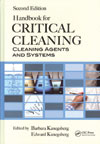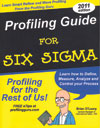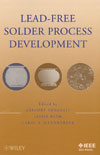

I love getting new books to review – it gives me the opportunity to learn from my peers and also see how much engineering people agree or disagree on design and process issues.
The following were all presented to this columnist after IPC APEX 2011 in Las Vegas. Needless to say, they were all posted to my office as they can be very heavy in your hand luggage.
How do I rate books? Well, by corner turnovers. Sorry to any librarians reading this page but I fold pages to remind me to go back and check a point or a reference. The more page turnovers, the greater the value of the book to me and hopefully others.
Handbook for Critical Cleaning – Second Edition
Edited by Barbara & Edward Kanegsberg.
Published by CRC Press.
530 pages in nine chapters with illustrations and photographs.

This is not one, but two books which can be purchased separately, I believe, depending on your area of interest. The range of cleaning topics is wide so it is really an engineering library resource rather than a personal reference book, unless your interest or job requirements cover all cleaning disciplines. I do recommend that engineers check the chapter listing for an insight into the wide scope of these titles.
There are a number of excellent chapters specific to electronics applications; these include materials, equipment, processes and failure modes. I particularly liked the chapter crafted by Mike Bixenman who highlights that the most important issue in cleaning is solubility, which is bang on and often overlooked by many engineers. I feel this chapter could be easily extended into a book with more illustration and examples.
I have always had an interest in clean-room environments and cleanliness levels after many hours spent monitoring particulate in manufacturing areas. Although there are selected books on the subject, this is a very good introduction and guide to requirements.
Cleaning printed board assemblies for selected applications is on the increase where no-clean has quite rightly dominated the marketplace for many years since the demise of CFCs. There are many reasons why cleaning is a hot topic again and this is a great time for the release of an encyclopaedia on the subject.
Profiling Guide for Six Sigma
By Brian O’Leary - KIC.
Published by DiggyPod.
148 pages in nine chapters with illustrations and photographs.

This is the first time I have seen this title. It has just been updated for 2011 and it is obvious from the front cover that the style of the book has been taken from another range of publications and the author has done what it says, ie, provided a practical guide to profiling for reflow soldering. The text also covers the profiling of wave soldering systems with many practical suggestions to improve the process and temperature measurement in general. The supporting video files from the dedicated website are a nice touch but more defect material is needed.
The author clearly describes the best ways to get the best out of temperature measurement systems and understand the real mechanics of thermocouples and the tolerances found during measurement. The complete text focuses on trying to help shop floor staff get the best measurements possible in the shortest time. It provides all the techniques and tips which will help reflow novices get better yields regardless of the profiling system used.
Clearly the author has a sense of humour but with it a lot of practical experience which comes across in this easy to follow book. The author may work for one well known profile system provider but the text is relevant to all suppliers as it is the profiling techniques that are the focus.
Lead-Free Solder Process Developments
Edited by Gregory Henshall, Jasbir Bath and Carol A Handwerker.
Published by Wiley & IEEE Press.
260 pages in 10 chapters with illustrations and photographs.

When I started reading this book I was a little disappointed with the continual references to other technical papers and resources but at the end of the final chapter I had found a lot of very useful and relevant material. The book provides an update on lead-free and all of the current problems facing the industry.The nice thing is there are also many practical solutions to these issues. I particularly enjoyed the sections on paste technology (presumably penned by one of the editors) which provided some very helpful hints and tips on the newer generation of materials.
Chapters cover legislation, reflow and wave soldering, rework, area array components, tin whiskers, in-circuit test and reliability for commercial and high-reliability electronics. The scope of the book provides something for everyone entering lead-free or those that have been dealing with the technology over the last few years. With the content reviewed by engineers from Flextronics, Jabil, Alcatel, Intel and Lockheed Martin, you can be confident about the level of material included.
Legislation leaves me cold but the first chapter gives a good overview of the current status, what the issues are and the future changes which will impact each company. Lead-free manufacturing changes have cost the industry a considerable amount of money not only in equipment but in the time invested in implementation and product proving from a reliability point of view. The assembly process has thrown up many issues of running cost with lead-free alloys but also the failure modes like pad cratering, tin whiskers, popcorning and delamination of substrates.
The rework chapter focused on the practical issues of extra heat input to product and the potential reliability issues. Copper leaching from substrates is another issue on many people’s minds and is covered in some detail. It is fair to say that some engineers in industry have taken rework for granted but proper planning and temperature profiling... that everyone must do. Test engineering issues are often overlooked in other text books but a very practical coverage was given by two HP engineers on test probe contact on test points and the impact of residues and the test point design. It is also clear that this is a high-profile issue due to the number of technical papers produced by paste suppliers on these issues.
Toyota Under Fire
Jeffrey K Liker.
Published by McGraw-Hill.
235 pages in five chapters with illustrations and photographs.

It has been very tough for Toyota, but a recent statement from the US Department of Transportation after a 10-month study said that “electronics are not to blame” for reported problems. Toyota has recalled nearly eight million vehicles in the US so this is some good news. NASA engineering was asked to look at computer control, electronic systems and electromagnetic interference and if they were a cause for the unintended acceleration issues that captured the headlines around the world. Industry discussion was all about electronics and the possibility of tin whiskers.
It is a very interesting read on the reality and the practical way in which lessons were learnt and positive action taken. There are countless references to different sources of information and reports. It is a long and winding story of the well publicised problems experienced by some drivers.
One statistic that I found amazing was the calls to Toyotas call centre after the one issue received wide publicity in the media. The Toyota service department’s 800 numbers went from 3000 calls a day to a staggering 96 000 calls and stayed at the same level for a week. However, the system to deal with this level of calls was state-of-the-art and the staff well trained and knowledgeable on the vehicles.
Reading this section clearly highlights the benefits of keeping call centres in-house with lots of practical knowledge rather than other support operations in different countries reading from scripts and clicking through countless checklists with a customer. This is a story that needed to be told and is done so very effectively.
For more information visit www.bobwillisonline.com

© Technews Publishing (Pty) Ltd | All Rights Reserved